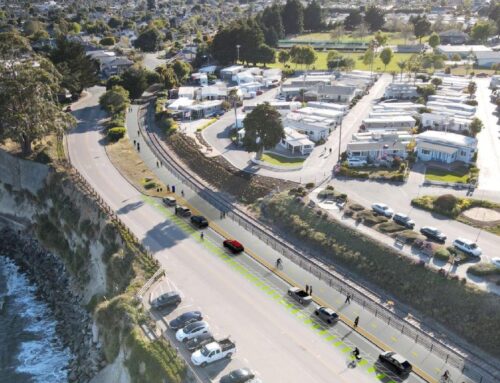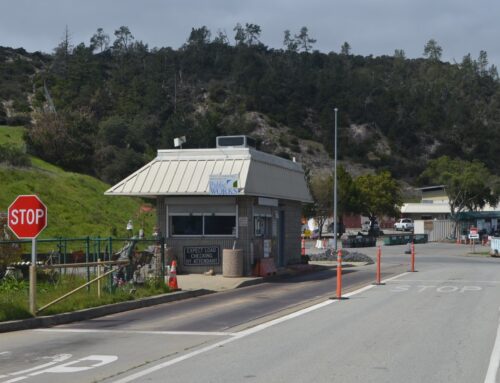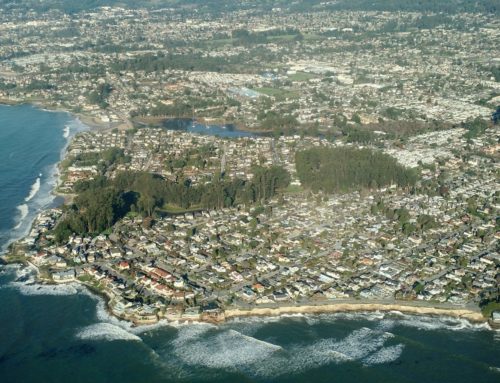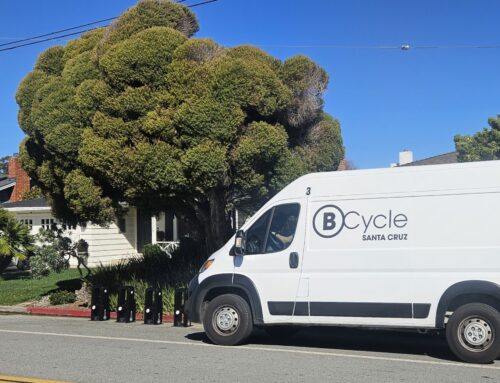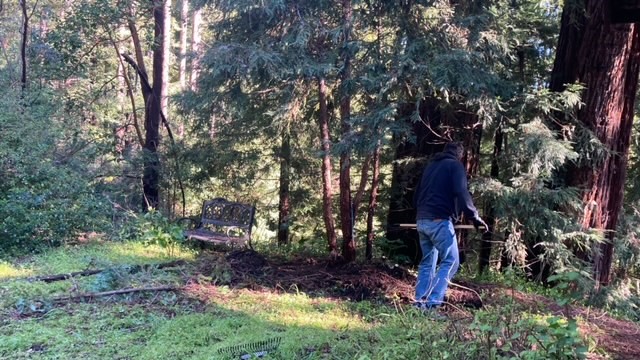
Marty Heaney rakes a Ben Lomond property as part of a Brush Brigade project that helps residents prepare their properties for wildfires. (Sherry Heaney — Contributed)
BEN LOMOND >> When the CZU Lightning Complex Fire roared through Santa Cruz County’s North Coast and approached the San Lorenzo Valley in August 2020, firefighters at times had to choose which properties they could defend based on how much brush and other fuel was near homes.
“When fighting wildfire, you have to take into consideration every property risk assessment. Can I safely defend this?” asked Felton Fire Chief Robert Gray. “When you’re going through a neighborhood that you’ve got to try to prepare for surviving a fire, you’re going to go to a house where you can do the most good.”
Gray said some homes did not have enough defensible space around them because the property owner lacked the money or the physical ability, or they “flat out did not want anyone telling them what to do.”
Since that historic blaze, brush clearing and wood chipping efforts have ramped up across the the valley and the Santa Cruz Mountains. A new volunteer group called the Brush Brigade recently started to help seniors and other residents haul away brush or cut it into wood chips.
A Firewise volunteer, Sherry Heaney of Scotts Valley, recruited San Lorenzo Valley High School students and others to help clear brush at three properties where senior residents needed help. They hope to involve more students from other schools in the project.
Heaney said the CZU Fire inspired her to form the group. “We were a long way away, but I know it could happen here,” Heaney said, “Once that happened, I had never done any dragging of brush. Now I’m at load 80” that she has dragged to the chipper or a truck. Another volunteer, Julie Kimball, has hauled vegetation to the Ben Lomond Transfer Station.
Brush Brigade volunteer Kathy Bennett of Ben Lomond said she thought the experience has given young people a vested interest in strengthening their community. She said the group is “a wonderful way to help the community, especially those with health issues or who are older.”
Bennett and her 13-year-old daughter, Meghan, recently helped remove fallen branches and leaves from an older woman’s rented property in Ben Lomond as part of the project. The woman’s husband recently died, and she didn’t have the money or physical ability to clear the debris around her property herself.
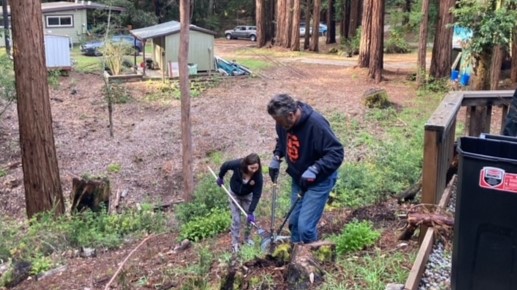
Volunteers Meghan Bennett and Marty Heaney clear vegetation near a home in Ben Lomond on April 1. Removing vegetation 5 feet from homes is one way to protect it from wildfire. (Sherry Heaney — Contributed)
The morning of April 1, the Brush Brigade began clearing the first 5 feet around the house, working their way outward.
Five volunteers were given rakes and carts to wheel loads of dead vegetation to a truck brought for the purpose. They hauled the debris into the back of the truck in industrial-grade plastic bags to be deposited at the Ben Lomond landfill.
“It was actually really fun,” said Meghan Bennett. “It was nice helping out other people,” she said. “It felt like we were able to restore the natural beauty of the home.”
Meghan lives with her family of seven on half an acre in Ben Lomond. They know firsthand how much work it takes to maintain defensible space from fire even for the young and able bodied.
The Brush Brigade’s volunteer work has been spreading at San Lorenzo Valley High School. Keegan Hickey, 15, heard about Brush Brigade during a morning announcement about the group at school.
“At the time I wasn’t exactly sure what it was for,” Keegan said. “But the name ‘Brush Brigade’ definitely piqued my interest.”
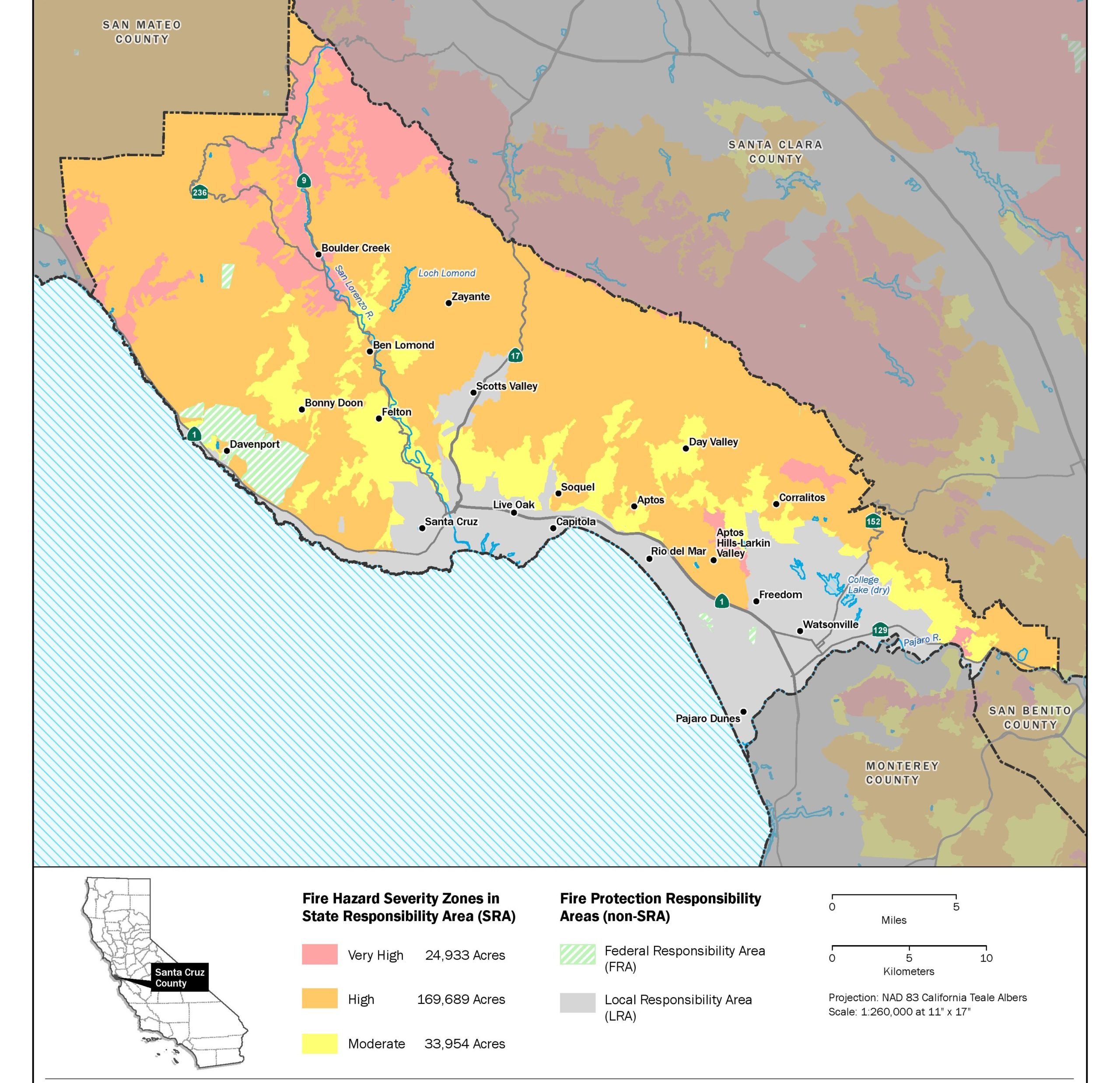
A November 2022 Cal Fire map shows large parts of the Santa Cruz Mountains in orange with “high” fire hazard severity. Fire hazard severity is “based on the physical conditions that create a likelihood and expected fire behavior over a 30- to 50-year period without considering mitigation measures such as home hardening, recent wildfire, or fuel reduction efforts,” according to Cal Fire.
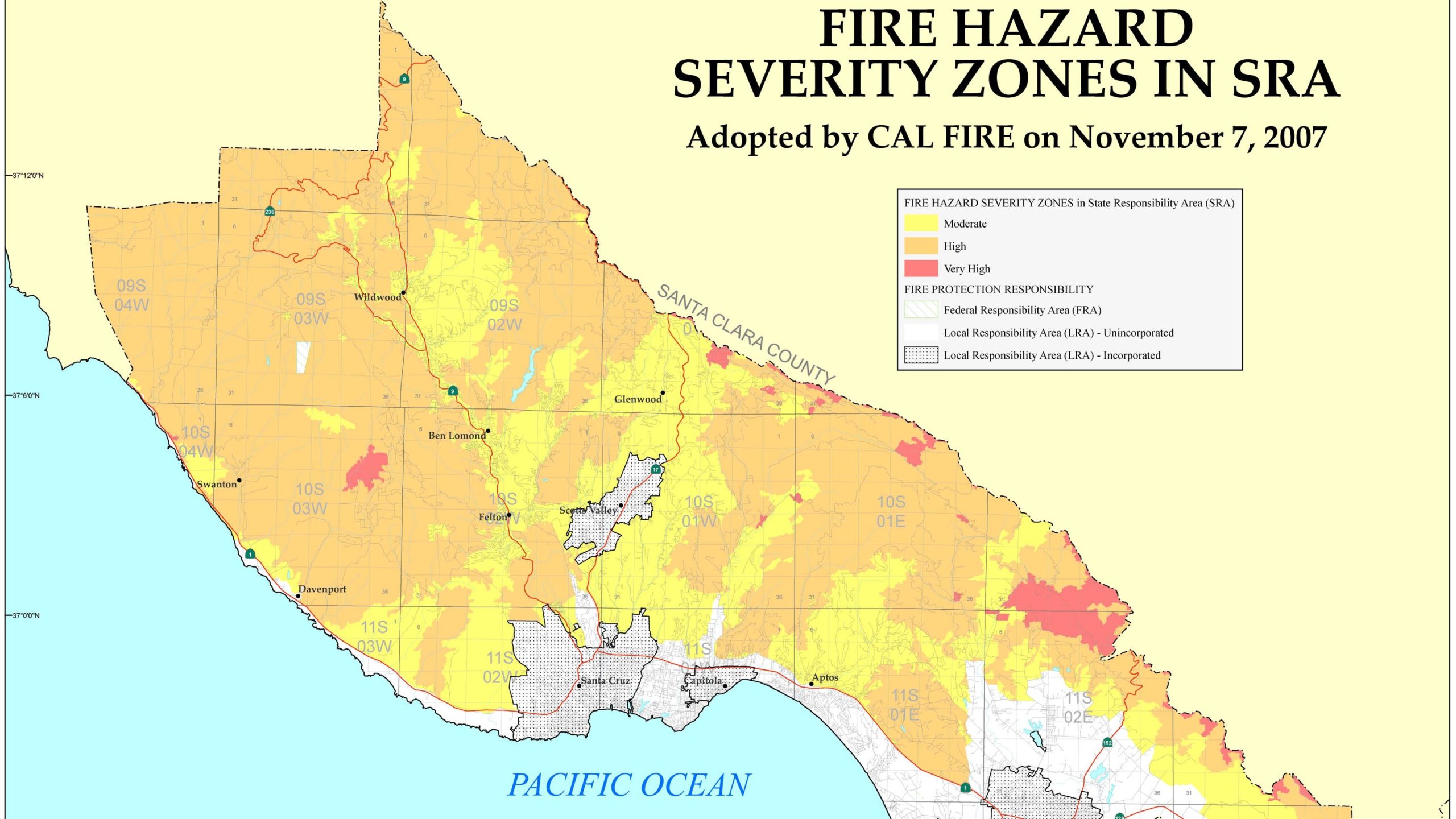
A 2007 Cal Fire map shows Fire Hazard Severity Zones in Santa Cruz County. (Cal Fire)
The CZU Fire missed Keegan’s home in Boulder Creek by a few miles, but some of his friends lost their homes and he remembers suffering with them during that time. When it was explained that he would be helping secure neighbors’ homes from wildfire, he wanted to get involved. In his view, it exemplified the community spirit in Santa Cruz County.
“It seemed like a great program, because I’ve gone through the fires and I can really have solidarity with the people I work with,” Hickey said.
More than half of Santa Cruz County residents live in the high fire-risk Wildland Urban Interface, which is one of the highest percentages in the state, according to a 2020 Santa Cruz County Civil Grand Jury report. Authorities expect a 20% increase in wildfire during the next 10 years, according to the 2022 Climate Action and Adaptation Plan.
Years of overgrown forest on private property helped exacerbate the CZU Fire, as did a lack of prescribed burns, decades of aggressive rural firefighting and thinly spread Cal Fire staff during lightning-sparked forest fires throughout California in August 2020.
Fire risks in Santa Cruz County
In November 2022, Cal Fire mapped Santa Cruz County according to Fire Hazard Severity Zones. Areas around Boulder Creek, Summit Road, the Aptos Hills and north of Corralitos had “very high” fire severity, based on expected fire behavior and conditions without fuel reduction efforts.
Gray, the Felton Fire chief, said that wildfire frequency and intensity have increased during his career as a firefighter. Climate change has been a factor in those trends, he said, and warmer summers and more intense winter storms are likely in the future.
“Back in ’96, if we had a 1-acre wildfire in Santa Cruz County in a year, that was a busy fire season. Now we’re getting those 5- to 10-acre fires a couple times a year,” Gray said.
Increased fire danger in the area means that residents and communities must play a more active role in clearing their brush around their homes and neighborhoods, he said. “I feel like there’s this expectation that the government does everything for you. The reality of it is there is a symbiotic relationship between [government and residents] that will keep people more fire safe,” said Gray. Gray said this is why programs like Brush Brigade are important.
The Brush Brigade helps residents for free. When possible, they request homeowners to sign up for the Santa Cruz County Resource Conservation District’s free yearly chipping program to shred any wood debris, which can be spread in gardens and scattered away from houses.
The Resource Conservation District opened applications for its no-cost chipping program for county residents east of Bonny Doon on April 1. Bonny Doon’s Fire Safe Council has its own chipping program.
This year, Heaney plans to increase her outreach to student volunteers. Eventually, she hopes Brush Brigade will be able to get its own chipper for the properties it helps clear.
“It’s still really small, just a pilot. But when we work with our volunteers we say, ‘Hey, when you go back to the high school, you know, please share your experience and encourage other people’,” Heaney said.
More information about Brush Brigade is available at [email protected] or 831- 234-8377.
Read more
- Wildfire preparation groups double in Santa Cruz County — July 23, 2021
- County needs plan to reduce wildfire fuel, civil grand jury reports — July 1, 2022
- Summit, Soquel residents band together to manage forests — June 24, 2022
- Podcast: Prescribed burns and wildfire in Santa Cruz County — Dec. 20, 2020
Questions or comments? Email [email protected]. Santa Cruz Local is supported by members, major donors, sponsors and grants for the general support of our newsroom. Our news judgments are made independently and not on the basis of donor support. Learn more about Santa Cruz Local and how we are funded.
Tyler Maldonado holds a degree in English from the University of California, Berkeley. He writes about housing, homelessness and the environment. He lives in Santa Cruz County.


